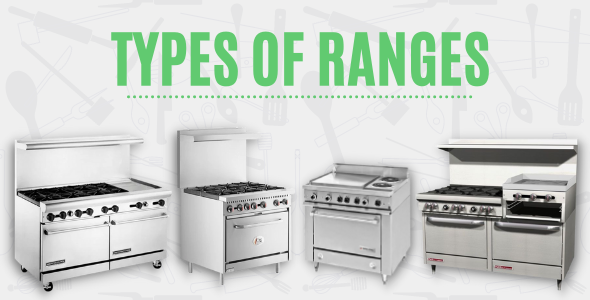Posted by Chantele Sineus on 14th Jul 2021
Buyer's Guide: Commercial Ranges
An essential centerpiece to every restaurant kitchen is the range. As a combination stovetop and oven, it is one of the most functional and flexible piece of cooking equipment on the market. Where else can you sizzle a steak to perfection, warm up some shells for Taco Tuesday, and boil pasta to a perfect al dente, all at the same time? When you buy a range it allows chefs and line cooks to boil, grill, fry, sauté, or simmer at the same time. You’re stretching the possibility of what you can cook in a limited space. And you can save money doing so. It’s an essential piece found in every kitchen, so it’s important to find the one that’s right for your needs.

Each of the range types listed below are designed for restaurant kitchens. They output an efficient amount of energy (measured in units called BTUs) for cooking in any fast-paced restaurant environment.
Restaurant Range
These are the most common type of range in the industry. Restaurant ranges are standalone models that come in various widths, from from 24 inches to 72 inches. If they’re gas, you’ll typically find the gas connection in the back of the unit. These ranges are smaller and lighter than your heavy-duty range. They are typically found in your local bistro, small to mid-size restaurants, or in bars.
Heavy Duty Ranges
Heavy duty ranges are much bigger than restaurant ranges. They’re intended to be banked together with other large pieces of equipment. These types of ranges are designed for high volume use and allow for more configuration options. These ranges also give off higher energy outputs per burner than your average range. This are usually found in cafeterias, banquet halls, or large size restaurants.
Electric Ranges
Electric ranges have protective hot tops over their burners. The hot tops cover the tubular metal elements and the resistance wires housed within these tubes. Being electrical, their power is measured in volts, and you can find them in 208V, 204V, and 480 V. Their thermostats typically display a range between 150 and 500 degrees Fahrenheit. Electric ranges are often easier and cheaper to install compared to other power sources.
Gas Ranges
Unlike electric, gas ranges have open burners. They typically have a BTU spanning from 25,000 to 260,000 and dials that allow for precise temperature control. Gas ranges heat up much more quickly than electric, instantly lighting up and ready to cook with right away, no wait time. Natural gas and liquid propane both perform efficiently on gas ranges. However, they require expensive hookups and equipment and different safety procedures.



